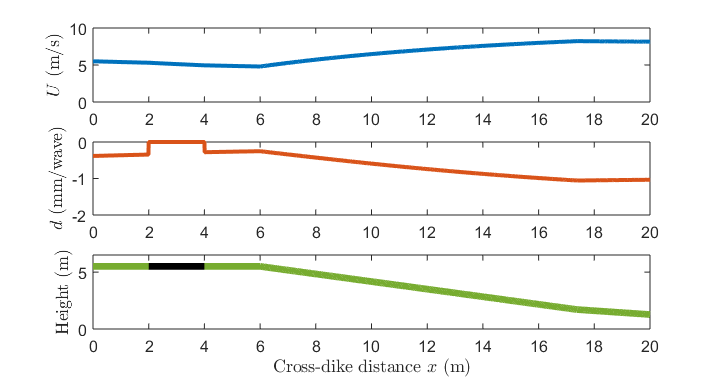V.M. van Bergeijk1*, J.J. Warmink1, S.J.M.H. Hulscher1
1University of Twente, This email address is being protected from spambots. You need JavaScript enabled to view it., This email address is being protected from spambots. You need JavaScript enabled to view it., This email address is being protected from spambots. You need JavaScript enabled to view it.
Introduction
Earthen dikes and dams are vulnerable for cover erosion by overtopping waves. Transitions in geometry and cover type can lead to more cover erosion because they increase the hydrodynamic load by creating extra turbulence and decrease the cover strength. The effect of transitions on the overtopping flow and the dike cover erosion along the dike profile is unknown. For that reason, we developed a coupled hydrodynamic-erosion model to study the effects of transitions and find the most vulnerable spot for cover erosion along dike profiles.
The Analytical Model
The analytical model couples the velocity formulas of Van Bergeijk et al. (subm) and the erosion formulas of Hoffmans (2012) to calculate the maximum overtopping flow velocity and the dike cover erosion along the dike crest and the adjacent landward slope for one wave. The analytical model is applied to a river dike with a road on the crest at Millingen a/d Rijn where an overtopping experiment was performed (Figure 1). The maximum flow velocity decreases along horizontal parts of the profile and increases on the slopes. The road does not erode and the grass cover only erodes when the critical flow velocity of 4.5 m/s is exceeded. The erosion depth is maximal at the end of the landward slope where the flow velocity is highest.
The Effect of Transitions
To study the effect of transitions on the dike cover erosion, the erosion model needs to be adapted to account for the extra turbulence created by the transitions and the reduced cover strength around transitions. Preliminary results showed that berms and revetments on the landward side reduce the flow velocity significantly and might be effective measures to reduce the dike cover erosion. Better understanding of the erosional effects of transitions can lead to improved dike design and assessment.
Figure 1: The flow velocity U, the erosion depth d and the cross-dike profile. The dike is covered in grass (green) with a road on the crest (black) and a transition in slope steepness around x=17.5 m.
Acknowledgements
This work is part of the research programme All-Risk, with project number P15-21, which is (partly) financed by the Netherlands Organisation for Scientific Research (NWO).
References
Hoffmans, G.J. 2012. The influence of turbulence on soil erosion. Eburon Uitgeverij BV.
Van Bergeijk, V.M., Warmink, J.J., Van Gent, M.R.A., Hulscher, S.J.M.H. (subm.). An analytical model for wave overtopping flow velocities on dike crests and landward slopes.










